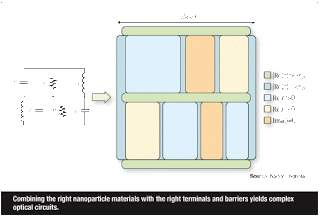Nader Engheta’s, professor at university of Pennsylvania, work provides “a vision, consisting of building blocks, along with instructions on how to arrange them together to enable transplanting well-known passive inductor-capacitor-resistor [LCR] electrical networks to the optical domain. This includes the direct optical realization of filters, antennas, power-distribution networks, microwave transmission-line metamaterials and many more. (H/T to EE Times and KurzweilAI.net). He has theories about creating equivalent structures for optical component versions for all of the components of electrical computers. Some of components would require new types of not yet created metamaterials to be developed.
An optical computer with nanoscale components would be able to be insanely fast. Designs could have massive levels of parallization, plus the speed boost from optical communication speeds and volumes versus slower electrical propogation. 
Negative-refractive-index materials were demonstrated less than a decade after John Pendry, a professor of theoretical physics at Imperial College London, proposed (hugely controversially) that they were possible. Such precedent may bode well for Engheta’s vision, some believe.
Two teams are already at work trying to demonstrate the basic nanocircuit principles. With his colleagues, Rohit Prasankumar of the Center for Integrated Nanotechnologies at Los Alamos National Laboratory is working on optical nanoantennas that he says should operate as lumped nanocircuit elements at visible wavelengths. “We are currently fabricating these nanoantennas and hope to test their operation as nanocircuits using optical scattering experiments shortly afterward,” Prasankumar said. “Sub- sequent experiments will include design, fabrication and testing of more-complex nanocircuits to achieve a desired functionality”–for example, nanotransmission lines.
Prasankumar sees the endeavor as “one of the most exciting developments to emerge from research into metamaterials and their applications in the last few years, particularly if we are successful in making Prof. Engheta’s theoretical ideas a reality. I am excited to be working on this project, and hope to have a working optical nanocircuit in the near future.”
Penn’s physics department is also working on the problem. “We plan to construct specially designed grating structures with periods much less than the operating wavelengths, and then experimentally verify the performance of such nanostructures in terms of optical reflection and transmission,” said Penn physicist Marija Drndic.
According to Engheta’s predictions, such nanostructures should act as optical filters at nanoscales, she said–for example, bandpass or bandstop filters depending on incident polarization. If successful, Drndic said, the experiment will show “that his concept of lumped circuit elements at optical frequencies will indeed provide useful recipes for design of optical nanocircuits with various functionalities.”
Here is Nader Engheta’s website
Engheta said he is interested the possibility of creating switches from metananocircuitry. They could lead to a new kind of optical information processing and, perhaps, a new form of nanoscale computational unit, said Engheta, the H. Nedwill Ramsey Professor of electrical and systems engineering at Penn.
Engheta’s theory relies on three basic ideas. The first is that nanoparticles of various materials have properties that can be matched to electronic equivalents (such as resistance, inductance and capacitance). Further, the nano- particles can be thought of as “lumped components” that can be connected together into circuits by using additional guiding structures. Finally, the concept of metamaterials–in which composite materials exhibit properties that are dictated by their nanoscale structures rather than their chemistry–is crucial for the design of efficient devices.
The building blocks in Engheta’s world are dielectric nanoparticles, Eleftheriades explained. Conventional dielectric nanoparticles–those with positive permittivity–“can realize optical capacitors,” he said, whereas negative plasmonic nanoparticles, which have negative permittivity, can realize optical inductors and resistors
.

Brian Wang is a Futurist Thought Leader and a popular Science blogger with 1 million readers per month. His blog Nextbigfuture.com is ranked #1 Science News Blog. It covers many disruptive technology and trends including Space, Robotics, Artificial Intelligence, Medicine, Anti-aging Biotechnology, and Nanotechnology.
Known for identifying cutting edge technologies, he is currently a Co-Founder of a startup and fundraiser for high potential early-stage companies. He is the Head of Research for Allocations for deep technology investments and an Angel Investor at Space Angels.
A frequent speaker at corporations, he has been a TEDx speaker, a Singularity University speaker and guest at numerous interviews for radio and podcasts. He is open to public speaking and advising engagements.

